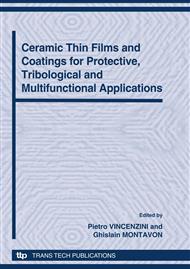[3]
2. Characterization of Frictional Behaviour The two different instruments enable the study of the frictional behaviour of this coating over a wide range of contact area from nanometric (AFM) to micrometric level (Tribometer) i. e., from a situation of single asperity to multiple asperity contact behaviour. Fig. 5(a) shows a typical plot of coefficient of friction against number of laps of traverse of the ball for 385 0C/4 hrs heat treated sample while Fig. 5(b) is the representative plot of lateral force measured against different normal forces for same sample. Fig 5a Fig 5b Fig. 5: (a) Coefficient of friction measured in ball on disk tribometer, (b) typical lateral force against normal force determined through AFM (385 0C/4 hrs heat treatment). Table 1 summarises all the data and clearly reveals that the steady state coefficient of friction is reduced through introduction of the Ni2B phase into the coating when tested in the AFM as well as by ball-on-flat tribometry. Fig. 5b exhibits a typical plot of lateral force against normal force showing a linear relationship consistent with Amonton's law. Table 1: Comparison of the coating's coefficient of friction from micro to nano level Sample heat treatment condition Coefficient of friction measured through micro-tribometer. Coefficient of friction measured through AFM. 300 0C/10 hrs.
Google Scholar
032 ± 0. 002 385 0C/4 hrs.
Google Scholar
018 ± 0. 001 430 0C rapidly cooled.
Google Scholar
017 ± 0. 001 Though there is more than one order of magnitude difference between them, AFM and micro-tribometer results display a similar trend. Calculations based on the Hertzian elastic contact model [11] show that in case of AFM, the contact is purely elastic. In contrast, the micro tribometer test reveals a well-developed groove (Fig. 6) after the test which indicates plastic yielding has occurred. Since all samples are tested under similar conditions in both experiments, it seems valid to infer from the increase of friction coefficient with increase in Ni3B content, that there is greater energy dissipation in Ni3B compared to Ni2B phase.
Google Scholar


